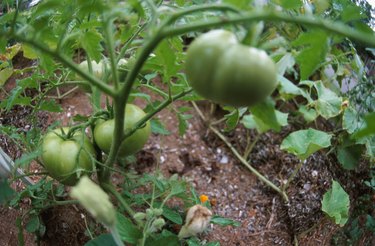
No one wants to see little white spots on their plants, which always indicate a problem or disease of some kind. Different pests and fungi may be responsible for the white spots you see, but the root cause of the spots could be relatively benign. Identify what's behind the problem to manage it effectively, and protect plants from damage.
Lighting
Video of the Day
All plants are sensitive to lighting conditions. Too little light will diminish fruiting, flowering and leaf development, but too much light is also harmful in its own way. Sun scald may result when plants are exposed to an excessive amount of sunlight. Leaves and fruits will become whitened or bleached by the sun when sun scald occurs. Sun scald is not highly damaging, but it does make plants look unattractive and unhealthy. Provide plants with shade to protect them from sun scald. If possible, transplant the plants to a more suitable (shadier) location.
Video of the Day
Diseases
Septoria leaf spot is a fungal disease that may cause white or grayish spots on leaves. The leaves will be surrounded by a brown or black ring. Bacterial canker also creates whitish spots on leaves, but they will be slightly raised off the surface of the leaf. The fungus that creates angular leaf spot forms white spots on fruits. The spots will become hard and crack open as the disease progresses. Powdery mildew fungus is named for the white, fuzzy spots it creates on leaves. In later stages, powdery mildew will cause leaves to turn yellow and wither. Powdery mildew does not usually affect fruits.
Scale
Scale are insects that attack a wide variety of garden plants. The insects are sucking pests that draw nutrients out of the leaves and stems of plants. Scales are extremely tiny, but they have a tendency to cluster together on leaves. When large populations of scale are present on plants, they look like white spots or blotches on leaves. Scale lay their eggs on the underside of leaves. The scale eggs are white and round, much larger than the individual scales themselves and visible with the naked eye. Scale may create heavy damage to plants as they deplete leaves of their nutrients.
Management
Disease and pest problems in the garden may be difficult to manage. On some plants, scale insects may be brushed off leaves by hand. Leaves may also be pruned and discarded when scale are present. Insecticide is not an advisable treatment to get rid of scale unless problems are severe, as the chemicals will destroy natural scale predators. Scale have a waxy coating that makes them highly resistant to insecticides. If insecticide is used, apply it in spring when it will damage scale eggs. Fungal diseases may spread quickly and become hard to control. Prune leaves that have been damaged by powdery mildew and destroy them. Use fungicide to stop the disease. Prevent powdery mildew and other fungal disease by keeping plants dry and well-ventilated. Healthy air flow prevents lingering moisture that encourages fungal growth. Angular leaf spot, which lives in soil through the winter, may be prevented with good crop rotation.
- Colorado State University Extension; Recognizing Tomato Problems; B. Edmunds, et al.; May 2009
- NDSU Extension; Disease Management In Home-Grown Cucumbers, Melons and Squash; H. Arthur Lamey; June 1991
- NDSU Extension; Common Insect Pests of Trees and Shrubs in North Dakota; Phillip Glogoza; October 1995
- Clemson Cooperative Extension; Euonymus Diseases & Insect Pests; Marjan Kluepfel, et al.; March 2000
- University of Minnesota Extension; Bacterial Leaf Diseases of Foliage Plants; F.L. Pfleger, et al.
- University of California Statewide IPM Program; Scales